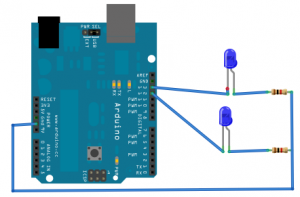
TCNT2 = 0 //initialize counter value to 0 TCCR2A = 0 // set entire TCCR2A register to 0 Set CS10 and CS12 bits for 1024 prescaler set compare match register for 1hz increments TCNT1 = 0 //initialize counter value to 0 TCCR1A = 0 // set entire TCCR1A register to 0 Set CS01 and CS00 bits for 64 prescaler set compare match register for 2khz increments


TCNT0 = 0 //initialize counter value to 0 TCCR0A = 0 // set entire TCCR0A register to 0 The main structure of the interrupt setup looks like this:
#Arduino millis with interrupts code#
I pretty much just copy the same main chunk of code and change the prescaler and compare match register to set the correct interrupt frequency. The code involved for setting up timer interrupts is a little daunting to look at, but it's actually not that hard. Normally when you write an Arduino sketch the Arduino performs all the commands encapsulated in the loop() function in an Arduino sketch. Jump straight to step 2 if you are looking for sample code.
#Arduino millis with interrupts how to#
In this instructable I'll explain how to setup and execute an interrupt in Clear Timer on Compare Match or CTC Mode. If the person is again not touching any button for 5 minutes, it again shall act like above (the automated behaviour).Timer interrupts allow you to perform a task at very specifically timed intervals regardless of what else is going on in your code. The other scenario is almost the same, but this time, someone has pushed a button and is watching LED X lit up. So it is meant as an automated animation. Until someone is really pushing a button, then it shall react to the real button push again. Press button X => LED X ON and all others off. So if I understand your project correctly: one switch can have an interrupt attached - but only one at a time). I'm not 100% sure interrupts are needed for a project like this.Īlso note that you can attach only one interrupt at a time (eg. I started answering the other day and then things went a little sideways here. But how to write the code to make it "after no button is pressed for 5 minutes, light up Pixel 1 for 30 seconds, then light up Pixel 2 for 30 seconds" and so on?Īlso.what if I want to have the lit up Pixel go off after 10 seconds after I have pushed its corresponding button?Īpologies for the late response. Still want to have the automated "playback". Also thought about switch case?īut maybe my solution is fine. I just set all other Pixels to black when pushing a button, except of the one I want to light up. Iam half way there.but without interrupts and the lazy road again. #include īuttonState2 = digitalRead(buttonPin2) // read the state of the pushbutton valueīuttonState3 = digitalRead(buttonPin3) // read the state of the pushbutton valueīuttonState4 = digitalRead(buttonPin4) // read the state of the pushbutton valueīuttonState5 = digitalRead(buttonPin5) // read the state of the pushbutton value So after 5 minutes the first Pixel shall light up for 30 seconds, goes off then and the second pixel lights up for 30 seconds, goes off then and the third pixel lights up and so on. So I also need that right? Or is there a better solution without interrupts, because there is not complicated pixel animation, just a solid color?!Īn extra would be to have an automated animation when no button is pressed for 5 minutes. I have read about a library where you can use every Pin as an interrupt Pin. And I have to hold the button to have the Pixel on, which is also not wanted for the new code of course. This I want to change to the behavier above. With this code I can light up all Pixels together when pushing all buttons together. Every button shall interrupt the lit up Pixel from another button and light up it´s corresponding Pixel. I think I have to use interrupts for this, because that´s what I want to do with those buttons. When I press any other button, the lit up Pixel shall go off and the pixel from the button I have pressed shall light up and so on.

When I press a button, the corresponding pixel shall light up (Button 3, Pixel 3 Button 1, Pixel 1 and so on). There are 8 Pixels and therefore 8 buttons. Let´s say I want to light them up with a solid color by pushing a button. But I want to progress, so I want to dive deeper into "how it should be done".įor my next project I want to use Neopixels again. To this day I always wrote code so it works for me, not very elegant and often not very like it should be written.


 0 kommentar(er)
0 kommentar(er)
